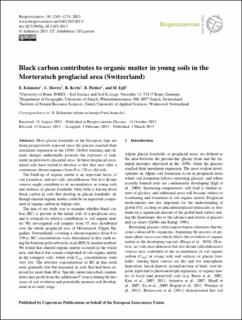Please use this identifier to cite or link to this item:
https://doi.org/10.21256/zhaw-4852Full metadata record
| DC Field | Value | Language |
|---|---|---|
| dc.contributor.author | Eckmeier, E. | - |
| dc.contributor.author | Mavris, C. | - |
| dc.contributor.author | Krebs, R. | - |
| dc.contributor.author | Pichler, B. | - |
| dc.contributor.author | Egli, M. | - |
| dc.date.accessioned | 2018-10-10T13:51:12Z | - |
| dc.date.available | 2018-10-10T13:51:12Z | - |
| dc.date.issued | 2013 | - |
| dc.identifier.issn | 1726-4189 | de_CH |
| dc.identifier.issn | 1726-4170 | de_CH |
| dc.identifier.uri | https://digitalcollection.zhaw.ch/handle/11475/11630 | - |
| dc.description.abstract | Most glacier forefields of the European Alps are being progressively exposed since the glaciers reached their maximum expansion in the 1850s. Global warming and climate changes additionally promote the exposure of sediments in previously glaciated areas. In these proglacial areas, initial soils have started to develop so that they may offer a continuous chronosequence from 0 to 150-yr-old soils. The build-up of organic matter is an important factor of soil formation, and not only autochthonous but also distant sources might contribute to its accumulation in young soils and surfaces of glacier forefields. Only little is known about black carbon in soils that develop in glacier forefields, although charred organic matter could be an important component of organic carbon in Alpine soils. The aim of our study was to examine whether black carbon (BC) is present in the initial soils of a proglacial area, and to estimate its relative contribution to soil organic matter. We investigated soil samples from 35 sites distributed over the whole proglacial area of Morteratsch (Upper Engadine, Switzerland), covering a chronosequence from 0 to 150 yr. BC concentrations were determined in fine earth using the benzene polycarboxylic acid (BPCA) marker method. We found that charred organic matter occurred in the whole area, and that it was a main compound of soil organic matter in the youngest soils, where total Corg concentrations were very low. The absolute concentrations of BC in fine earth were generally low but increased in soils that had been exposed for more than 40 yr. Specific initial microbial communities may profit from this additional C source during the first years of soil evolution and potentially promote soil development in its early stage. | de_CH |
| dc.language.iso | en | de_CH |
| dc.publisher | European Geosciences Union | de_CH |
| dc.relation.ispartof | Biogeosciences | de_CH |
| dc.rights | http://creativecommons.org/licenses/by/3.0/ | de_CH |
| dc.subject.ddc | 551: Geologie und Hydrologie | de_CH |
| dc.title | Black carbon contributes to organic matter in young soils in the Morteratsch proglacial area (Switzerland) | de_CH |
| dc.type | Beitrag in wissenschaftlicher Zeitschrift | de_CH |
| dcterms.type | Text | de_CH |
| zhaw.departement | Life Sciences und Facility Management | de_CH |
| zhaw.organisationalunit | Institut für Umwelt und Natürliche Ressourcen (IUNR) | de_CH |
| dc.identifier.doi | 10.21256/zhaw-4852 | - |
| dc.identifier.doi | 10.5194/bg-10-1265-2013 | de_CH |
| zhaw.funding.eu | No | de_CH |
| zhaw.issue | 3 | de_CH |
| zhaw.originated.zhaw | Yes | de_CH |
| zhaw.pages.end | 1274 | de_CH |
| zhaw.pages.start | 1265 | de_CH |
| zhaw.publication.status | publishedVersion | de_CH |
| zhaw.volume | 10 | de_CH |
| zhaw.publication.review | Peer review (Publikation) | de_CH |
| zhaw.webfeed | Bodenökologie | de_CH |
| Appears in collections: | Publikationen Life Sciences und Facility Management | |
Files in This Item:
| File | Description | Size | Format | |
|---|---|---|---|---|
| 2013_Eckmeier_Black_carbon_contributes_to_organic_matters.pdf | 2.05 MB | Adobe PDF |  View/Open |
Show simple item record
Eckmeier, E., Mavris, C., Krebs, R., Pichler, B., & Egli, M. (2013). Black carbon contributes to organic matter in young soils in the Morteratsch proglacial area (Switzerland). Biogeosciences, 10(3), 1265–1274. https://doi.org/10.21256/zhaw-4852
Eckmeier, E. et al. (2013) ‘Black carbon contributes to organic matter in young soils in the Morteratsch proglacial area (Switzerland)’, Biogeosciences, 10(3), pp. 1265–1274. Available at: https://doi.org/10.21256/zhaw-4852.
E. Eckmeier, C. Mavris, R. Krebs, B. Pichler, and M. Egli, “Black carbon contributes to organic matter in young soils in the Morteratsch proglacial area (Switzerland),” Biogeosciences, vol. 10, no. 3, pp. 1265–1274, 2013, doi: 10.21256/zhaw-4852.
ECKMEIER, E., C. MAVRIS, R. KREBS, B. PICHLER und M. EGLI, 2013. Black carbon contributes to organic matter in young soils in the Morteratsch proglacial area (Switzerland). Biogeosciences. 2013. Bd. 10, Nr. 3, S. 1265–1274. DOI 10.21256/zhaw-4852
Eckmeier, E., C. Mavris, R. Krebs, B. Pichler, and M. Egli. 2013. “Black Carbon Contributes to Organic Matter in Young Soils in the Morteratsch Proglacial Area (Switzerland).” Biogeosciences 10 (3): 1265–74. https://doi.org/10.21256/zhaw-4852.
Eckmeier, E., et al. “Black Carbon Contributes to Organic Matter in Young Soils in the Morteratsch Proglacial Area (Switzerland).” Biogeosciences, vol. 10, no. 3, 2013, pp. 1265–74, https://doi.org/10.21256/zhaw-4852.
Items in DSpace are protected by copyright, with all rights reserved, unless otherwise indicated.